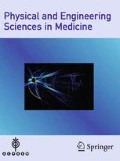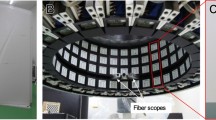Abstract
Imaging the brain of a freely moving small animal using positron emission tomography (PET) while simultaneously observing its behaviour is an important goal for neuroscience. While we have successfully demonstrated the use of line-of-response (LOR) rebinning to correct the head motion of confined animals, a large proportion of events may need to be discarded because they either ‘miss’ the detector array after transformation or fall out of the acceptance range of a sinogram. The proportion of events that would have been measured had motion not occurred, so-called ‘lost events’, is expected to be even larger for freely moving animals. Moreover, the data acquisition in the case of a freely moving animal is further complicated by a complex attenuation field. The aims of this study were (a) to characterise the severity of the ‘lost events’ problem for the freely moving animal scenario, and (b) to investigate the relative impact of attenuation correction errors on quantitative accuracy of reconstructed images. A phantom study was performed to simulate the uncorrelated motion of a target and non-target source volume. A small animal PET scanner was used to acquire list-mode data for different sets of phantom positions. The list-mode data were processed using the standard LOR rebinning approach, and multiple frame variants of this designed to reduce discarded events. We found that LOR rebinning caused up to 86 % ‘lost events’, and artifacts that we attribute to incomplete projections, when applied to a freely moving target. This fraction was reduced by up to 18 % using the variant approaches, resulting in slightly reduced image artifacts. The effect of the non-target compartment on attenuation correction of the target volume was surprisingly small. However, for certain poses where the target and non-target volumes are aligned transaxially in the field-of-view, the attenuation problem becomes more complex and sophisticated correction methods will be required. We conclude that there are limitations with the LOR rebinning approach and simplified attenuation correction for freely moving animals requiring the development and validation of more sophisticated approaches.











Similar content being viewed by others
References
Nakao Y, Itoh Y, Kuang TY, Cook M, Jehle J, Sokoloff L (2001) Effects of anesthesia on functional activation of cerebral blood flow and metabolism. Proc Natl Acad Sci USA 98:7593–7598
Momosaki S, Hatano K, Kawasumi Y, Kato T, Hosoi R, Kobayashi K, Inoue O, Ito K (2004) Rat-PET study without anesthesia: anesthetics modify the dopamine D1 receptor binding in rat brain. Synapse 54:207–213
Johnson EA, Sharp DS, Miller DB (2000) Restraint as a stressor in mice: agianst the dopaminergic neurotoxicity of D-MDMA, low body weight mitigates restraint-induced hypothermia and consequent neuroprotection. Brain Res 875:107–118
McDougall SJ, Lawrence AJ, Widdop RE (2005) Differential cardiovascular responses to stressors in hypertensive and normotensive rats. Exp Physiol 90:141–150
Fulton R, Meikle S, Kyme A, Zhou V, Popovic K, Kassiou M, Akhtar M (2009) Motion-corrected microPET brain imaging of conscious rats. World Molecular Imaging Conference, Montreal
Zhou VW, Kyme AZ, Meikle SR, Fulton R (2008) An event driven motion correction method for neurological positron emission tomography studies of awake laboratory animals. Mol Imaging Biol 10:315–324
Kyme A, Zhou V, Meikle S, Popovic K, Akhtar M, Fulton R (2009) Motion tracking of fully conscious small animals in PET. Conference record of the IEEE nuclear science symposium and medical imaging conference, pp 2561–2566
Weisenberger AG, Gleason SS, Goddard J, Kross B, Majewski S, Meikle SR, Paulus MJ, Pomper M, Popov V, Smith MF, Welch BL, Wojcik R (2005) A restraint-free small animal SPECT imaging system with motion tracking. IEEE Trans Nucl Sci 52:638–644
Schulz D, Southekal S, Junnarkar SS, Pratte J-F, Purschke ML, Stoll SP, Ravindranath B, Maramraju SH, Krishnamoorthy S, Henn FA, O’Connor P, Woody CL, Schlyer DJ, Vaska P (2011) Simultaneous assessment of rodent behavior and neurochemistry using a miniature positron emission tomography. Nat Methods 8:347–352
Cherry S (2011) Functional whole-brain imaging in behaving rodents. Nat Methods 8:301–303
Kyme A, Meikle S, Baldock C, Fulton R (2012) Tracking and characterizing the head motion of unanaesthetized rats in positron emission tomography. J R Soc Interface 9:3094–3106
Zhou V, Eisenhuth J, Kyme A, Akhtar M, Fulton R, Meikle S (2013) A motion adaptive animal chamber for PET imaging of freely moving animals. IEEE Trans Nucl Sci (in press)
Menke M, Atkins MS, Buckley KR (1996) Compensation methods for head motion detected during PET imaging. IEEE Trans Nucl Sci 43:310–317
Bloomfield PM, Spinks TJ, Reed J, Schnorr L, Westrip AM, Livieratos L, Fulton R, Jones T (2003) The design and implementation of a motion correction scheme for neurological PET. Phys Med Biol 48:959–978
Fulton R, Nickel I, Tellmann L, Meikle S, Pietrzyk U, Herzog H (2003) Event-by-event motion compensation in 3D PET. Conference record of the IEEE nuclear science symposium and medical imaging conference, pp 3286–3289
Montgomery AJ, Thielemans K, Mehta MA, Turkheimer F, Mustafovic S, Grasby PM (2006) Correction of head movement on on PET studies: comparison of methods. J Nucl Med 47:1936–1944
Rahmim A, Bloomfield P, Houle S, Lenox M, Michel C, Buckley KR, Ruth TJ, Sossi V (2004) Motion compensation in histogram-mode and list-mode EM reconstructions: beyond the event-driven approach. IEEE Trans Nucl Sci 51:2588–2596
Thielemans K, Mustafovic S, Schnorr L (2003) Image reconstruction of motion corrected sinograms. Conference record of the IEEE nuclear science symposium and medical imaging conference, pp 2401–2406
Verhaeghe J, Reader AJ (2010) A PET superset data framework for exploitation of known motion in image reconstruction. Med Phys 37:4709–4721
Rahmim A, Dinelle K, Cheng J-C, Shilov MA, Segars WP, Lidstone SC, Blinder S, Rousset OG, Vajihollahi H, Tsui BMW, Wong DF, Sossi V (2008) Accurate event-driven motion compensation in high-resolution PET incorporating scattered and random events. IEEE Trans Med Imaging 27:1018–1033
Parra L, Barrett HH (1998) List-mode likelihood: EM algorithm and image quality estimation demonstrated on 2D PET. IEEE Trans Med Imaging 17:228–235
Reader AJ, Manavaki R, Zhao S, Julyan PJ, Hastings DL, Zweit J (2002) Accelerated list-mode EM algorithm. IEEE Trans Nucl Sci 49:42–49
Qi J, Huesman RH (2002) List mode reconstruction for PET with motion compensation: a simulation study, in conference record IEEE symposium. biomedical. imaging, pp 413–416
Huesman RH, Qi J, Samaras D, Wang Y, Yang L, Zhang W, Ferrieri R, Vaska P, and Schlyer D (2004) Direct list mode reconstruction for motion compensation. Conference record of the IEEE nuclear science symp and medical imaging conference, pp 3953–3955
Carson RE, Barker WC, Liow J-S, Johnson CA (2003) Design of a motion-compensation OSEM list-mode algorithm for resolution-recovery reconstruction for the HRRT. Conference record of the IEEE nuclear science symposium and medical imaging conference, pp 3281–3285
Picard Y, Thompson CJ (1997) Motion correction of PET images using multiple acquisition frames. IEEE Trans Med Imaging 16:137–144
Tai Y-C, Ruangma A, Rowland D, Siegel S, Newport DF, Chow PL, Laforest R (2004) Performance evaluation of the microPET Focus: a third-generation microPET scanner dedicated to animal imaging. J Nucl Med 46:455–463
Kyme AZ, Zhou VW, Meikle SR, Fulton RR (2008) Real-time 3D motion tracking for small animal PET. Phys Med Biol 53:2651–2666
Defrise M, Liu X (1999) A fast rebinning algorithm for 3D PET using John’s equation. Inverse Prob 15:1047–1065
Hudson HM, Larkin RS (1994) Accelerated image-reconstruction using ordered subsets of projection data. IEEE Trans Med Imaging 13:601–609
Fulton R, Tellmann L, Pietrzyk U, Winz O, Stangier I, Nickel I, Schmid A, Meikle S, Herzog H (2004) Accuracy of motion correction methods for PET brain imaging. Conference record of the IEEE nuclear science symposium and medical imaging conference, pp 4226–4230
Polycarpou I, Tsoumpas C, Marsden PK (2012) Analysis and comparison of two methods for motion correction in PET imaging. Med Phys 39:6474–6483
Zhou WV, Leung WC, Kyme A, Meikle SR, Fulton R (2009) Compensation for lost events in LOR rebinning motion correction for PET. Conference record of the IEEE nuclear science symposium and medical imaging conference, pp 3140–3145
Zhou V, Kyme A, Meikle S, Fulton R (2013) Reducing event losses in sinogram-based PET motion correction by extending the axial field of view. IEEE nuclear science symposium and medical imaging conference, Seoul, Korea, 27 Oct–02 Nov 2013
Zhou VW, Kyme AZ, Meikle SR, Fulton R (2011) Event-based motion correction for PET transmission measurements with a rotating point source. Phys Med Biol 56:2651–2665
Acknowledgments
We thank Wencke Lehnert, Kata Popovic and Wesley Ng Ping Man from the Brain & Mind Research Institute (University of Sydney) for their assistance in performing the microPET studies. This work was supported by Australian Research Council Discovery Project Grant DP0988166.
Author information
Authors and Affiliations
Corresponding author
Rights and permissions
About this article
Cite this article
Akhtar, M., Kyme, A., Zhou, V. et al. An investigation of the challenges in reconstructing PET images of a freely moving animal. Australas Phys Eng Sci Med 36, 405–415 (2013). https://doi.org/10.1007/s13246-013-0222-0
Received:
Accepted:
Published:
Issue Date:
DOI: https://doi.org/10.1007/s13246-013-0222-0




